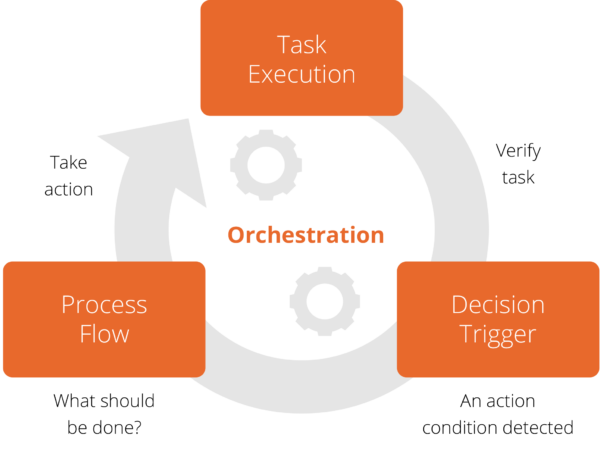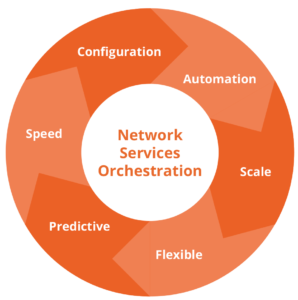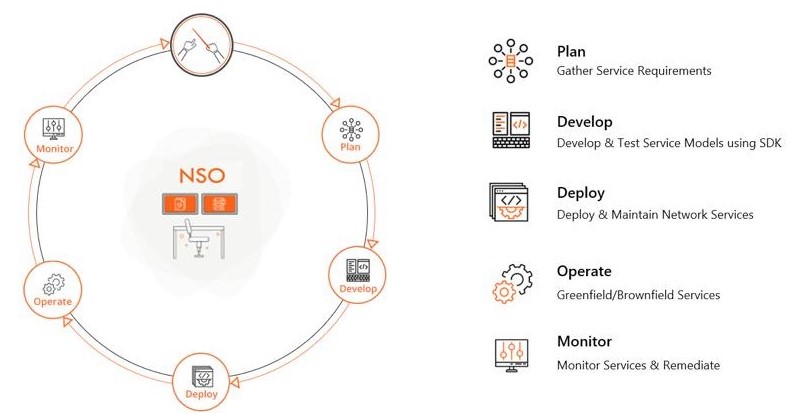What is Network Orchestration?
To quote Greg Ferro, Network Orchestration is an application that can take a request from a customer via a web portal for new virtual server requiring provisioning. This ideal app will analyze the network configuration and implement the configuration change for the customer and then update the billing system. The network itself might implement in the physical network, in a virtual overlay on hypervisors, across the WAN via encrypted tunnel or one of many other options. The connectivity is far less important than the orchestrated service establishment across many devices and platforms.
Network Orchestration uses the concept of abstraction to capture network configuration, operational data and policy in a vendor-neutral format and integrates with self-service portals. The network architects customize built-in service models, and Orchestrator will take care of the differences in underlying infrastructure. As a result, the network operators don’t have to learn complex CLIs from multiple vendors and network services can be rolled out within minutes. For example, let’s say the operator has to create a VLAN for a specific application. In the traditional approach, the operator has to login to every router and configure using CLI or GUI. On the other hand, a Network Orchestration automatically discovers the network topology and all the dependencies for creating a VLAN. It auto-generates the CLI or API calls for each vendor device and executes an atomic transaction across all devices.

Automation vs Orchestration?
To quote Ivan Pepelnjak,
Enabling an interface? Automation.
Configuring a VLAN on a switch? Automation.
Creating interface descriptions based on LLDP neighbors? Automation.
Creating a VLAN service by enabling edge interfaces, configuring access VLANs, creating VLAN-to-VXLAN mappings, and testing the end-to-end connectivity? Orchestration.
What are the business benefits of Network Orchestration?
Network Orchestration avoids technology and vendor lock-in for investment protection. It allows easy integration and automation with customers’ self-service portals, 3rd party web-applications, and OSS/BSS via REST APIs and has no hard-coded parameters for the rollout of new device types and new services.
Customers can Realize immediate ROI through a low-risk approach. Initially, Network Orchestration can run side-by-side with the existing EMS/NMS solutions or replace them if needed. On average, Network Orchestration has a payback period of 6 months.

Network Orchestration helps customers increase revenue by quicker time-to-market. By designing and deploying new services so much faster, time-to-market is reduced from months to a few hours. New device types previously unknown to the system are rolled out in 15 minutes via configurable MIB polling policies and rules. Moreover, automated services of predefined custom-designed service templates are provisioned via GUI or REST API to maximize network agility and programmability.
Network Orchestrations lowers OpEx and CapEx. It dramatically improves cost structure through complete vendor independence and automation of key processes of purpose-built multi-vendor networks based on customized hardware and silicon via full REST API to unify traditional network management and open, SDN-style network programmability and Service Lifecycle Orchestration.
Network Orchestration reduces the overall complexity of the network by eliminating operational silos and unifies all management functions across end-to-end, multi-vendor and multi-layer networks into a single-pane-of-glass platform.
Where is the Network Orchestration ROI?
A recent McKinsey study revealed that more than $60B is spent on Network Operations Labor and Tools annually.
- 75% of OpEx is spent on Network changes and troubleshooting.
- 90% of the network changes are performed manually
- 70% of policy violations occur due to human error
Network Orchestration reduces OpEx, avoids human errors, eliminates outages and introduces consistency

Productivity
Initially, the ROI on Network Orchestration will appear low as it requires extra investment in staff to develop the workflows and service models. However, as the deployment grows and the demand for services increases, the ROI will improve. When Network Orchestration is implemented successfully, the required staff level shrinks even as the demand for services increases. The ROI is so compelling that beyond a demand threshold, Network Orchestration becomes mandatory.
The cost savings such as labor reduction, reduced cost of errors and top-line revenue effects are easy to quantify. But there are other potent soft benefits such as brand reputation, agility, competitive differentiation and flexibility to pursue new opportunities.
Quality
Network Orchestration introduces consistency that automatically improves quality. Quality leads to good reputation and more business. Many Customers witnessed dramatic improvements in metrics such as the number of outages, mean time to repair and the staff required to troubleshoot the outages.
Adaptability
Network Orchestration checks on conditions and acts based on policies. The Service will be adapted to changing demands yielding a quicker time to market and better quality. Ultimately, the system becomes nimbler to introduce new services.
Network Orchestration formalizes the closed-loop behavior within all aspects of network operations. Each action will be validated and documented to fine tune the decision process. The software detects every change in the infrastructure and offloads the operators by automating some of the decisions in
real-time. With higher predictability, the network team can embrace newer challenges to support changing business demands.
What is the Network Orchestration Lifecycle?
Network Orchestration coupled with real-time Telemetry automates Service Assurance in a closed-loop system. With Network Orchestration, Network Architects can deploy a predictive and proactive system that generates insights for Application, Client, and Compliance to isolate cause in few clicks.

Plan
During the planning phase, Network admin collects standardized configurations for existing or planned services. The information could be a simple text file with CLI commands or sample API calls with parameters.
Product Managers and Network architects can describe the service they want to offer on their infrastructure. They can use built-in Service Models (starter kits) to describe various network services such as L2 VPN, L3 VPN, IWAN, App Delivery, etc. Network Orchestration also provides service model framework using which you can extend these starter kits with SLAs.
Develop
DevOps teams can take the starter kits, introduce business logic, workflow and integrate with 3rd party software in the infrastructure and define SLA metrics as part of the service template. Network Orchestration also provides a normalized network model. The developers don’t need to know the semantics of individual vendor devices. Network Orchestration simplifies the task for the devops team, so they can develop a common code base that works for multiple deployments. Network Orchestration provides development toolkits, code generators to automate most of this task. DevOps can customize for various vendors and use-cases, introduce versioning, release management to infrastructure using YANG models.
Deploy
The services are advertised in a self-service catalog or OSS/BSS using the REST API. When someone orders a service, the whole service chaining happens automatically. The Orchestrator uses service models, and devices models to auto-generate commands and executes the workflow. If any device is unavailable or fails to provision, the entire service will be rolled back to the previous state to ensure consistency. Network Orchestration provides lots of operational support including Packaging & Versioning, Integration into Ecosystem, Upgrades & Maintenance.
Operate
Network Orchestration discovers the infrastructure, brownfield service discovery and has vendor plug-ins. Network Orchestration introduces self-service through GUI or comprehensive REST API and integrates with ticketing systems. Network Orchestration introduces self-service and on-demand provisioning to the network infra and avoids inconsistencies & human errors.
Telemetry and Monitor
Network Orchestration constantly streams real-time telemetry data from the infrastructure through audit and reconciliation. Network Orchestration validates policy against infrastructure to provide better visibility for SLA assurance. With deep machine learning and correlation, Network Orchestration can predict performance and proactively remediate operational issues before they become outages.
How does Network Orchestration support various deployments?
Use-case 1: Application Delivery Automation
Use-case 2: Branch and CPE Management
Use-case 3: Provisioning L2 VPN
Use-case 4: Interconnecting multiple clouds
Use-case 5: Multi-Vendor Firewall Management
Use-case 6: Managed Service Provider Solutions